Figure 1. Video in EdPuzzle with some embedded questions
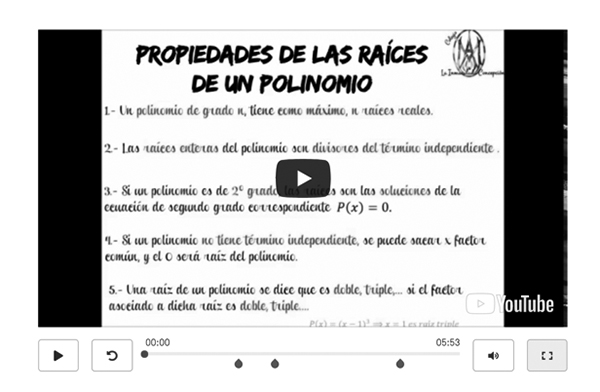
CRISTINA JIMÉNEZ(1), MARÍA ARANTZAZU JADRAQUE(2), ÁNGEL ALBERTO MAGREÑÁN(3) AND LARA ORCOS(2)
(1) Universitat Politécnica de Valencia (Spain)
(2) Universidad Internacional de La Rioja (UNIR) (Spain)
(3) Universidad de La Rioja (Spain)
DOI: 10.13042/Bordon.2021.89586
Fecha de recepción: 22/05/2021 • Fecha de aceptación: 27/09/2021
Autor de contacto / Corresponding author: Ángel Alberto Magreñán. E-mail: angel-alberto.magrenan@unirioja.es
INTRODUCTION. One of the main objectives of Mathematics education is to motivate students since their interest in Mathematics is very low in many cases and, in others, even null. The use of different technologies has grown a lot in the last decades and several authors in the area have demonstrated their effectiveness in the classroom. In addition, the use of different Information and Communication Technologies, which students can use in their own homes, is also growing. METHOD. In this study, the use of the EdPuzzle application is presented, under the paradigm of the Flip Learning methodology in the third year of the Secondary Education Level for learning polynomial factorization in a school in Spain in two different courses, taught by the same teacher. To carry out the experience, the average grades of two exams have been taken, the first one related to polynomials and the basic concepts, used as a pretest since it has the main basic concepts that the student must know before continuing, and another related to the polynomial factorization, used as a posttest, and the scores obtained by the group that used EdPuzzle were compared with those that did not use it. RESULTS. Comparison of both groups shows that the scores are significantly higher in the group that used EdPuzzle in the posttest. DISCUSSION. The Cohen’s d effect size obtained was almost medium, and the questionnaire answers were positive, aspects that make EdPuzzle a tool to be considered in the teaching-learning process of Mathematics.
Keywords: Flipped Classroom, Algebra, Educational technology, Mathematics education, Video technology.
The constant advances in society and in the technological field imply the development of new classroom methodologies more suited to the needs of our students. The rise in the use of technological resources in all areas of our daily lives, makes it necessary to implement them in the classroom, to be able to respond effectively to the students´ learning process requirements (Marín et al., 2018Marín, D., Vidal, M. I., Peirats, J. & López, M. (2018). Gamificación en la evaluación del aprendizaje: valoración del uso de Kahoot! In REDINE (ed.), Innovate strategies for Higher Education in Spain (pp. 8-17). Adaya Press.). Moreover, the use of technology and different tools can help in understanding factorization since it will allow the use of different simulations and experiments. In this sense, there are different studies based on the use of virtual resources that can help in algebra learning, such as (Garzón & Bautista, 2018Garzón, J. & Bautista, J. (2018). Virtual Algebra Tiles: a pedagogical tool to teach and learn algebra through geometry. Journal of Computer Assisted Learning, 34(6), 876-883.) or (Pincheira & Vásquez, 2021Pincheira, N. & Vásquez, C. (2021). Recursos virtuales para la enseñanza del álgebra: un aporte para la priorización curricular chilena frente a la pandemia de la COVID-19. Unión-Revista Iberoamericana de Educación Matemática, 17(61), e009-e009.). Considering the current global pandemic situation caused by SARS CoV-2, the need for the development of new methodologies and tools has been more latent than ever as well as the need to develop the digital competence that teachers should have in order to become a manager or even an e-innovator as it appears in Sosa & Valverde (2020Sosa, M. & Valverde, J. (2020). Perfiles docentes en el contexto de la transformación digital de la escuela. Bordón. Revista de Pedagogía, 72(1), 151-173. https://doi.org/10.13042/Bordon.2020.72965 ), these need has also appeared at university levels related to the use of Information and Communication Tools (ICT) (Casillas et al. 2020Casillas, S., Cabezas, M., Ibarra, M. & Rodríguez, G. (2020). El profesorado universitario en la sociedad del conocimiento: manejo y actitud hacia las TIC. Bordón. Revista de Pedagogía, 72(3), 45-63. https://doi.org/10.13042/Bordon.2020.76746 ). Distance teaching in the Secondary Education stage has been a real teaching challenge, not only in terms of explaining the content, but also in terms of evaluation and monitoring of the students’ skills. As established by David Kolb’s Experiential Learning Theory, knowledge is created through the transformation of one’s own experience in such a way as to produce a dialectic between action-reflection and experience-abstraction (Kolb & Kolb, 2008Kolb, A. Y. & Kolb, D. A. (2009). Experiential learning theory: a dynamic, holistic approach to management learning, education and development. In S. J. Armstrong & C. V. Fukami (eds.), The SAGE handbook of management learning, education and development, 42, 68. http://dx.doi.org/10.4135/9780857021038.n3). This type of learning improves students’ thinking by themselves (Armsby, 2013Armsby, P. (2013). Developing professional learning and identity through the recognition of experiential learning at doctoral level. International Journal of Lifelong Education, 32(4), 412-429. https://doi.org/10.1080/02601370.2013.778070) as well as their levels of self-confidence (Cornell et al., 2013Cornell, R., Johnson, C. & Schwartz, J. W. (2013). Enhancing student experiential learning with structured interviews. Journal of Education for Business, 88(3), 136-146. http://dx.doi.org/10.1080/08832323.2012.659296).
One of the most common problems found by students in Mathematics learning is related to algebra and more concrete in polynomial factorization. In this way, Méndez (2012Méndez, T. (2012). Marco figural como medio para factorizar polinomios cuadráticos. Bolema: Boletim de Educação Matemática, 26(44), 1395-1416. ), gave a proposal for the learning of quadratic factorization based on figural context and using the ideas of Douady (1986Douady, R. (1986). Jeux de cadres et dialectique outil-objet. Recherches en Didactique des Mathématiques, 7(2), 5-31. https://revue-rdm.com/1986/jeux-de-cadres-et-dialectique/). Moreover, authors such us Mejía (2012Mejía, M. F. (2012). ¿Cómo se podría enseñar la factorización de polinomios integrando calculadoras simbólicas y lápiz y papel? In O. Gilberto (ed.), Memorias del 13.er Encuentro Colombiano de Matemática Educativa (pp. 1171-1177). Sello Editorial Universidad de Medellín.) proposed the use of the Computational Algebraic System (CAS) of symbolic calculators, together with paper and pencils to teach polynomial factorization. In the last years, other authors and teachers such us, Ottmar et al. (2015Ottmar, E., Landy, D., Weitnauer, E. & Goldstone, R. (2015). Graspable Mathematics: using perceptual learning technology to discover algebraic notation. In Integrating touch-enabled and mobile devices into contemporary Mathematics education (pp. 24-48). IGI Global.), Weitnauer et al. (2016Weitnauer, E., Landy, D. & Ottmar, E. (2016, December). Graspable math: towards dynamic algebra notations that support learners better than paper. In 2016 Future Technologies Conference (FTC) (pp. 406-414). IEEE.) or Hulse (2019Hulse, T. (2019). Graspable Math K-12: perspectives and design for formative assessment of mathematical proficiency with learning technologies [Phd Thesis]. https://digital.wpi.edu/concern/etds/6q182n667), supervised by Ottmar and other professors, using ICTs and Graspable Math, a dynamical learning technology, to develop experiences to teach Algebra and polynomial factorization.
In this sense, methodologies such as Flip Classroom or reverse class are very useful under this paradigm in which teachers and students have been immersed during these months. This methodology arises as an evolution of the “peer instruction” Crouch & Mazur (2001Crouch, C. H. & Mazur, E. (2001). Peer instruction: ten years of experience and results. American Journal of Physics, 69(9), 970-977. https://doi.org/10.1119/1.1374249) and “just-in-time teaching” methods (Novak et al., 1999Novak, G. M., Gavrin, A., Wolfgang, C. & y Patterson, E. (1999). Just-in-time teaching: blending active learning with web technology. Prentice Hall PTR.) and its foundation is based on obtaining the maximum possible performance of the moments in which the teacher is with the student in the classroom. The Flipped Classroom is a pedagogical model that consists of “inverting” the traditional class, in such a way that the student works on the main concepts through a video or document at home and in the classroom this knowledge is established through activities and teacher-led dynamics. As Webel (2018Webel, C. Sheffel, C. & Conner K. A. (2018). Flipping instruction in a fifth-grade class: a case of an elementary Mathematics specialist. Teaching and Teacher Education, 71, 271-282. https://doi.org/10.1016/j.tate.2018.01.007) says “Flipped instruction is ‘flipped’ because it departs from the traditional structure in which class time is used to provide direct instruction, while applications of learned content are assigned for individual practice or homework” (p. 4). In this way, the autonomous learning of the student, who acquires knowledge through peer practice, is favored, in such a way that errors, approaches and impressions are exchanged (Sein-Echaluce et al., 2017Sein-Echaluce, M. L., Fidalgo- Blanco, Á. & García Peñalvo, F. J. (2017). Trabajo en equipo y Flip Teaching para mejorar el aprendizaje activo del alumnado. Proceedings of IV Congreso Internacional sobre Aprendizaje, Innovación y Competitividad, 610-615. https://doi.org/10.26754/CINAIC.2017.000001_129). The four pillars of this methodology are: a flexible environment, in which multiple activities can be developed; learning culture, since the class must be student-centered; content intentionality, class times must be maximized for problem solving, etc.; and the role of the teacher, the teacher is not replaced by videos, he or she is the facilitator of learning in the class moments (Hadman et al., 2013Hamdan, N., McKnight, P., McKnight, K. & Arfstrom, K. M. (2013). The Flip Learning Model: a white paper based on the literature review of Flipped Learning. http://flippedlearning.org/wp-content/uploads/2016/07/WhitePaper_FlippedLearning.pdf). It is interesting to highlight the study carried out by Cronhjort et al. (2017Cronhjort, M., Filipsson, L. & Weurlander, M. (2017). Improved engagement and learning in flipped-classroom calculus. Teaching Mathematics and Its Applications, 37(3), 113-121. https://doi.org/10.1093/teamat/hrx007) based on the improvement that involves the implementation of the Flip methodology in the learning process in the calculus class. In their study, the normalized gain value, as an indicator of the learning process, was 13% higher in the experimental group, a group that had used the inverse class methodology, than in the control group.
According to Mazcuñán (2015Mazcuñán, E. M. (2015). Creación de lecciones a partir de vídeos con EdPuzzle. In Tele (in) 2 series: nuevos enfoques en la aplicación práctica de la innovación docente (pp. 47-52). ), the teacher’s challenge consists in providing students with the appropriate materials and resources so that they can successfully face autonomous study, and thus, develop formative evaluation mechanisms to assess their learning and verify the correctness of their conclusions. The formative assessment favors the improvement of the teaching-learning-evaluation processes, providing feedback to the students so that they reflect and optimize their learning (Romero-Martín et al., 2015Romero-Martín, R., Castejón-Oliva, F. J. & López-Pastor, V. (2015). Divergencias del alumnado y del profesorado universitario sobre las dificultades para aplicar la evaluación formativa. RELIEVE-Revista Electrónica de Investigación y Evaluación Educativa, 21(1). https://doi.org/10.7203/relieve.21.1.5169). Therefore, the evaluation of the learning process is crucial in the formation of the student, and due to this reason, it is necessary to advocate the use of tools that allow a continuous evaluation of learning. In the study with seventh grade students (12-13 years old) carried out by Margosian (2018Margosian, K. (2018). Examining the effect of Flipped Learning on English language learner mathematics achievement. [Master´s Thesis]. California State University. https://digitalcommons.csumb.edu/caps_thes_all/295), the level of achievement in mathematical standards was compared through a pre-test and a post-test between two groups: control group, who worked in a traditional way and an experimental one, who worked through the Flip methodology. The results show how the difference between the two questionnaires was significant in the experimental group. A very useful tool in the Flip methodology is EdPuzzle, which is used to convert a video into a lesson that, in addition, reports measurable results for a formative assessment. It is based on a directed learning in which the student has to answer different type of questions (open-ended and multiple choice for example), that are embedded in the video, in order to reach the end of the video and where everything is reflected, including the response time, the answer given or the correct answer, so that the teacher can know those aspects that the student has understood worse. A deeper description of EdPuzzle is shown in Section 2. As Orcos et al. (2018Orcos, L., Blázquez, P., Curto, M., Molina, F. J. & Magreñán, Á. A. (2018). Use of Kahoot and EdPuzzle by smartphone in the classroom: the design of a methodological proposal. In L. Uden, D. Liberona & J. Ristvej (eds.), Learning technologies for educational challenges (pp. 37-47). 10.1007/978-3-319-95522-3_4), comment in the same way, the daily correction of the video-questionnaire by the teacher will allow them to know in real time, that part of the content that the students have learnt worse, being the genesis of this review, that of reinforcing those concepts not yet learned. The study carried out by Curto et al. (2019Curto, M., Orcos, L., Blázquez, P. J. & León, F. J. M. (2019). Student assessment of the use of Kahoot in the learning process of science and mathematics. Education Sciences, 9(1), 55.) based on the use of Kahoot shows that, globally, students consider that these types of tools help them to self-assess their learning process, which is more active and experiential and give them the possibility of showing better what they have been learning, aspects which are very interesting from the point of view of the metacognitive process.
Authors such as Pintor et al. (2014Pintor, E., Gargantilla, P., Herreros, B. & López, M. (2014). Kahoot en docencia: una alternativa practica a los clickers. In XI Jornadas Internacionales de Innovación Universitaria. Universidad Europea de Madrid. http://abacus.universidadeuropea.es/bitstream/handle/11268/3603/x_jiiu_2014_322.pdf?sequence=2&isAllowed=y) indicate that the use of this type of questionnaires in which the students respond to certain questions posed by the teacher through an electronic device, in addition to obtaining several evidence of the student learning process, encourage active collaboration and increase student motivation, through games and student competition. In another sense, this type of online questionnaires would also help us detect learning problems that certain students may have with a certain content, requiring special attention in them, and using the data extracted from the online questionnaire, to know their evolution and development.
The study carried out by Pueo et al. (2017Pueo, B., Jiménez-Olmedo, J., Carbonell-Martínez, J. & Penichet-Tomas, A. (2017). Aplicación de la herramienta EdPuzzle como experiencia transversal de clases invertida en distintas etapas educativas. XARXES-INNOVAESTIC 2017 (pp. 208-209). Universidad de Alicante.) was based on the use of validated questionnaires to evaluate the impact of EdPuzzle on the teaching-learning process of students through the number of views, reaching positive results. As mentioned in the study “the results suggest that the success of the flipped class may be due to the role of direct instruction with audiovisual support through dedicated videos, rather than the relocation of such instruction” (p. 694). On the other hand, the study carried out by Wilson (2016Wilson, A. (2016). The Flipped Approach: the use of embedded questions in Math videos. [Master thesis]. University of Texas. https://scholarworks.utep.edu/open_etd/983/) worked with control group, which used videos about Geometry and Measurement without embedded questions and an experimental group that did. The study variables were several such as the number of views of the video, the quality of the written work, the scores obtained, among others, also obtaining better results in the experimental group.
In Mathematics, for the Secondary stage, EdPuzzle is a great resource that more and more teachers are employing, since students can watch a short and concise video at home, in which they will find the explanation of the concept that they will work in the classroom the next day and answer some questions and dedicate the class session entirely to practice with exercises and problems. The work presented by Coa (2018Coa, R. E. (2018). Aprendizaje experiencial y el EdPuzzle en la solución de problemas contextualizados de sistemas de ecuaciones de matemática básica en estudiantes de una universidad privada 2018-I [Master´s Theses], Technological University of Perú. Lima. http://repositorio.utp.edu.pe/handle/UTP/1554) based on the use of EdPuzzle in solving problems of systems of equations with three variables, shows how the use of the tool had a positive impact on students. This study includes an experience, based on the use of EdPuzzle, for learning of polynomial factorization in the third course of Secondary Education Level in a Spanish School. The results show that:
Most of the students liked EdPuzzle, because it was interesting and a new way of learning to solve problems. It is important generate new ways of presenting contextualized mathematical problems that engage and motivate the students to solve them, in our case one of those ways was the EdPuzzle (Coa, 2018Coa, R. E. (2018). Aprendizaje experiencial y el EdPuzzle en la solución de problemas contextualizados de sistemas de ecuaciones de matemática básica en estudiantes de una universidad privada 2018-I [Master´s Theses], Technological University of Perú. Lima. http://repositorio.utp.edu.pe/handle/UTP/1554, p. 106).
EdPuzzle
The tool selected and used in this study is EdPuzzle (https://edpuzzle.com/), a platform that allows editing a video by adding explanations and questions, designed to verify if the students have seen it and if they are understanding the concepts explained. Moreover, it can also serve as a means of evaluation by obtaining the results of the questions asked. In this way the student had to pay attention to the contents explained and the teachers have the record with the responses of the students and the time they have dedicated to it.
It is a very easy tool to use, once the teacher registers, he or she can start creating the classes and uploading his or her own videos or those of the internet. Once the video is uploaded or created, it can be edited. In Figure 1 an example of a video is shown, where 3 multiple choice questions are embedded (the symbols below the timeline).
|
Figure 1. Video in EdPuzzle with some embedded questions 
|
The video stays hosted in the teacher´s content ready to be assigned. Once the video is assigned, a start and end date can be established so students can see that content. In “my classes” section it is the list of all the assignments that are made to each group and the total number of students who have seen the video, as it can be seen in Figure 2.
|
Figure 2. One class in EdPuzzle with some videos 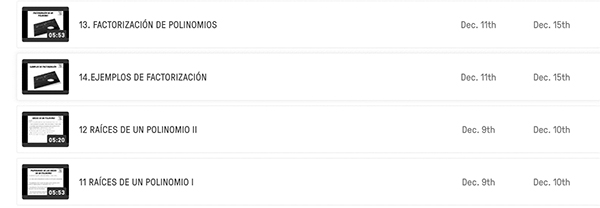
|
When a specific assignment is opened, the list of students in that group will appear, as well as the video watching progression bar, the number of questions correctly answered and the date and time when they were asked. In Figure 3 it is shown the progress of each student in one of the videos. The teacher can also check, student by student, what are the questions they have not been able to answer and the time they have dedicated to the video.
From the student’s point of view, when an assigned video begins to work, the number of questions that will have to be answered appears and it does not allow the use of the controls to advance the video forward, since it is blocked, so it is compulsory to see it until the end.
Once they arrive at the proposed question, the tool gives the option of watching the video again, to verify that they are understanding it well before answering. What is not allowed is to continue watching the video until the question is answered as it is shown in Figure 3.
|
Figure 3. Student interface of one question embedded in the video 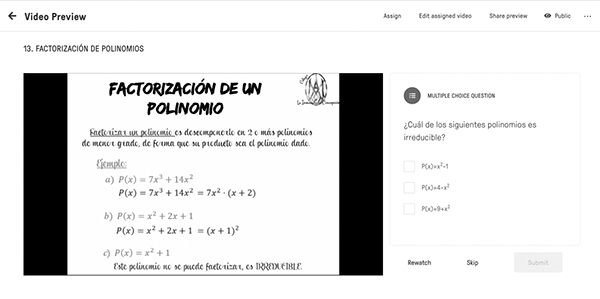
|
After answering the question, the student will always receive feedback that indicates if their answer is correct, so during all the activity the student is aware of whether they are acquiring the mathematical content correctly or not, which is essential for the development of the skill related to learn how to learn. Subsequently, the student will continue watching the video until the next scheduled question or entry, as it can be seen in Figure 4.
|
Figure 4. Student interface of one correct answer 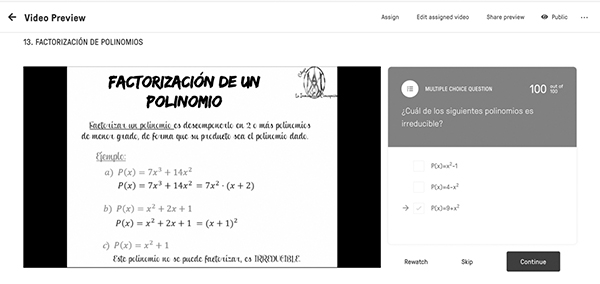
|
In this section, the methodology will be presented including the sample, the procedure, the collection tools used, and the data analysis carried out.
Sample
For the development of this study, there was taken a sample of 70 students from two different courses of Mathematics, from the Secondary Education level in a school placed in Spain. Students distributed in two different courses, 40 from the third course of year 2018/2019 which are used as control group and other group of 30 students of the third course of the year 2020/2021 who have completely seen all the videos in which students have also carried out the exams in person. The experimental group was composed by 30 students, 60% were women and, 40% men and the range of age was 13-15 years old. The control group was composed by 40 students, 70% of women and 30% of men and the range of ages was the same.
The decision of using groups of different courses was due to the fact that the teacher detected that in the control group, who worked the theory through the use videos, these were not effective because some students played video, but they did not put attention to it. She decided to include EdPuzzle, that enables the embedding of questions which have to be answered in order to continue, so students must attend to the video. A pilot experience was carried out in the following year but due to the pandemic and the lockdown, that experience was used to improve the content, the questions and the quality of the videos. In order to guarantee the groups are homogeneous, the pretest was used as it has the basic contents related to polynomials.
Procedure
This activity is designed with the purpose of reviewing the contents of the factorization of polynomials of the third-year curriculum in Secondary Education in Spain (RD 1105, 2014Real Decreto de 1105/2014, de 26 de diciembre, por el que se establece el currículo básico de la Educación Secundaria Obligatoria y del Bachillerato (2014), Boletín Oficial del Estado, 3, sec. I, de 3 de enero de 2015, 169 a 546. https://www.boe.es/eli/es/rd/2014/12/26/1105). It is a dynamic, motivating activity that requires a broad involvement on the part of the student. The work of the videos by the students at home, has a weight of 10% of the final grade of the evaluation, and is evaluated from the results obtained in EdPuzzle, related to the view of the videos.
In the 2019/2020 academic year a new tool has been introduced to try to solve understanding problems. In order to prove the applicability of the tool during the months that the lockment has lasted in Spain, the tool has been used in order to monitor those students who had actually seen the video and, most importantly, to introduce different questions and annotations throughout the video itself, that the student had to answer to be able to continue watching it. This first experience showed that this tool can be used in a positive way in the learning process as homework and as a doubt solving tool, so an experience, based on EdPuzzle, was performed to proof its effectiveness.
Is this experience, a class experience based on Flipped Learning was carried out. A sequence of 5 short videos (between 4 and 6 minutes), including the main ways to obtain the factorization of a polynomial and examples of the factorization of polynomials, were created, considering aspects related to the contents to work, the duration of the video, videos cannot be too long and the ways of presenting the information in the videos. To obtain the perception of the study a survey where constructed and send to the participants in order to know how they feel with the tool and if the use of it increased or not their motivation.
In this paper, the main objectives are related to reflect on the use of EdPuzzle for the learning of polynomial factorization and also to know the perceptions of the students about to the use of the tool in the Mathematics learning.
Data collection tools
The data of the study are based on the qualifications obtained by the students in two different exams: one related to basic concepts of polynomials, including polynomial operations, which was used as pretest, as this exam has the previous contents they need to know before facing factorization, and the factorization one, used as posttest. Both the pretest and the posttest are equal with the exception of the numbers associated to the coefficients of the polynomials involved. On the other hand, students have also answered a questionnaire related to the user experience about the applicability of the tool in Mathematics classroom.
Data analysis
First, to compare the qualifications obtained in both exams, and in comparison, with the two years, the descriptive statistics have been calculated. Moreover, the mean differences have been studied, between both years in the two exams, and the Students´ T statistic in independent samples was used to compare it. Moreover, the size effect was also computed to compare both groups. Finally, a descriptive analysis of the questionnaire responses is shown, also showing some relations between some of the answers.
This section presents the results of the qualifications on both exams and also the perceptions of the students about the tool.
Descriptive statistics for all students
Table 1 shows the descriptive statistics of the mean of the two tests obtained by students in general.
| Table 1. Descriptive statistics associated to the tests | |||||||||
|
From the data shown in Table 1, there exists a clear decrease in the main qualifications associated to the factorization test and that is why this study was carried out, to try to increase motivation and understanding of factorization processes.
Descriptive statistics for each group
Figure 5 shows the mean qualifications obtained by the control and experimental group in both tests.
As it can be seen in Figure 5, the differences in the qualifications of polynomials exams between the two groups is less 0.43 but the differences in the factorization tests are greater than one point. Moreover, it can be seen that the differences obtained between both exams in each year are different, in the control group the differences between the qualification in both exams are greater than 1.6 points but in the experimental group the differences are lower than 1 point.
|
Figure 5. Descriptive statistics associated to the tests in both groups 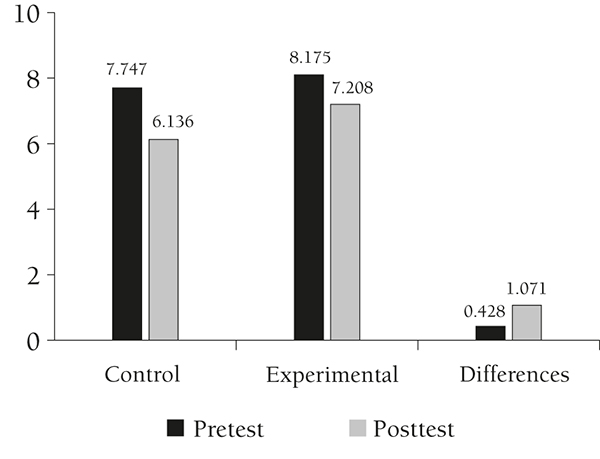
|
Comparison of means between both groups
To check if there have been differences in the pretests between the students belonging to the two groups, Student’s T test for independent groups is used and its associated values are shown in Table 2.
| Table 2. Student’s T test for independent groups | ||||||||
|
As it is shown, the differences between the pretests are no significant in between both groups, so the knowledge about polynomials is homogeneous (this fact is also contrasted by teachers in classroom). The Student’s T test for the comparison of the posttests is shown in Table 3 where it appears that the differences in means in the posttest are significant, choosing the critical value as .05. It is also shown in Table 3, the effect size associated is close to a medium value and significative. The effect size, as it can be seen in MacLeod (2019McLeod, S. (2019). What does effect size tell you? Simply Psychology. https://www.simplypsychology.org/effect-size.html), means that the difference is not trivial, it is statistically significant and also the percentage of control group below the mean of experimental group is close to 69%.
| Table 3. Student’s T test for independent groups | ||||||||||
|
Answers to the questionnaire related to the perception of EdPuzzle
As part of the experience, students also answered a questionnaire, with two different parts, the first one related to their experience with EdPuzzle, in general, and the second one related to the use of EdPuzzle lo learn Mathematics. The questionnaire has several types of questions. On the one hand, Likert-type questions (1-4) being 1 totally in disagreement and 4 totally in agreement, and, on the other hand, numerical questions to assess the experience both in general and in relation to Mathematics. Moreover, there are open-ended questions.
Answers to the questionnaire related to the perception of EdPuzzle in general
The first part of the questionnaire is related to the perception of EdPuzzle in general. The answers can be seen in Figure 6, where the following general questions were included, related to technical aspects such as:
|
Figure 6. Answers about the EdPuzzle perceptions (Q1, Q2 & Q3) 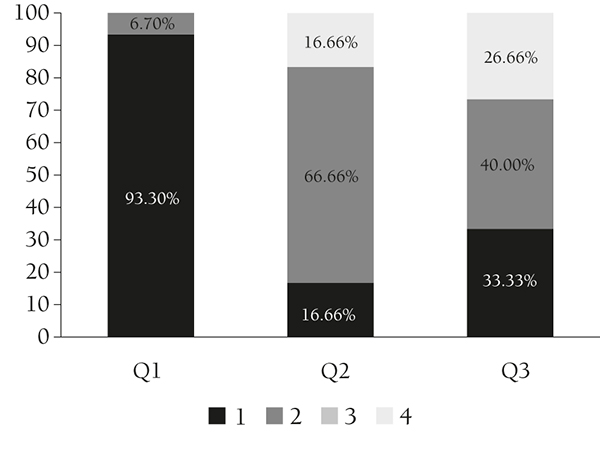
|
As can be seen, most of the students did not know the tool, so it was a challenge for them to use it and an extra motivation. On the other hand, it is clear from Figure 6 that the duration in general seemed adequate and that the connection did not influence excessively.
According to aspects related to the experience itself, the following questions were raised regarding the general use of the tool:
The answers about the EdPuzzle perceptions Q4, Q5 and Q6 can be seen in Figure 7, where it highlights that the vast majority of students have the perception that the tool is easy to use, that they would like it to be used more continuously and that they would like to use it in other subjects.
|
Figure 7. Answers about the EdPuzzle perceptions (Q4, Q5 & Q6) 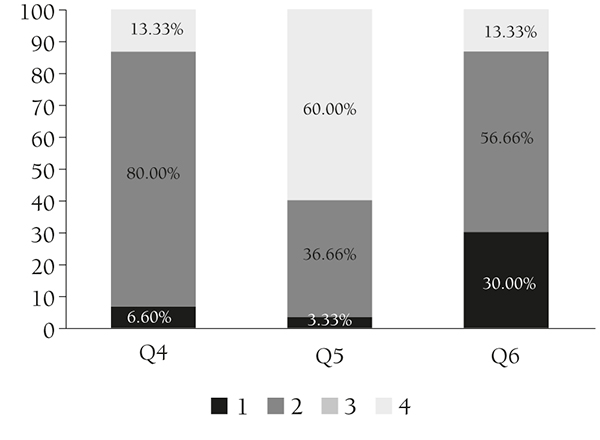
|
The answers about the EdPuzzle perceptions Q7, Q8, Q9 and Q10 can be seen in Figure 8. Most of students find it a good tool to work at home as well as enjoyable and a good complement to face-to-face classes. Finally, as seen in Q9, it is remarkable that 80% of students prefer this tool to others used to work at home.
|
Figure 8. Answers about the EdPuzzle perceptions (Q7, Q8, Q9 & Q10) 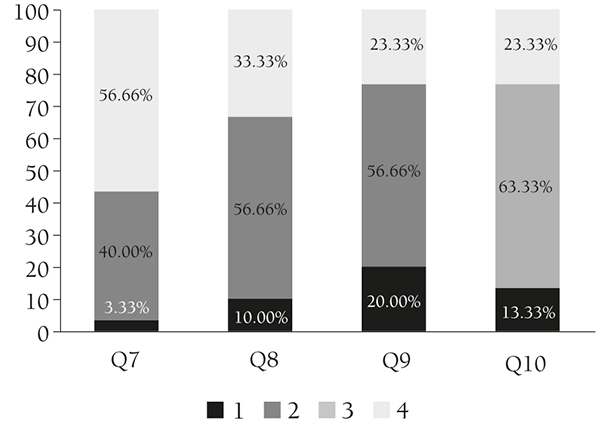
|
Finally, the mean value given to the tool is 7.23 points, so students value the experience in a remarkable way, highlighting the “8” as the most repeated answer.
Answers to the questionnaire related to the perception of EdPuzzle for Mathematics learning
Regarding the experience with the tool in relation to learning of Mathematics, the following questions were included:
The answers about the EdPuzzle perceptions Q11, Q12, Q13, Q14 and Q15 can be seen in Figure 9, where it stands out that the vast majority of students believe that working with the tool helps them to make Mathematics seem easier, to internalize them better, to understand the procedures and to clarify the contents. On the other hand, regarding the interest in Mathematics, Q12 shows it is noteworthy that 43.33% of the students consider that using EdPuzzle aroused interest in Mathematics.
|
Figure 9. Answers about the EdPuzzle perceptions (Q11, Q12, Q13, Q14 & Q15) 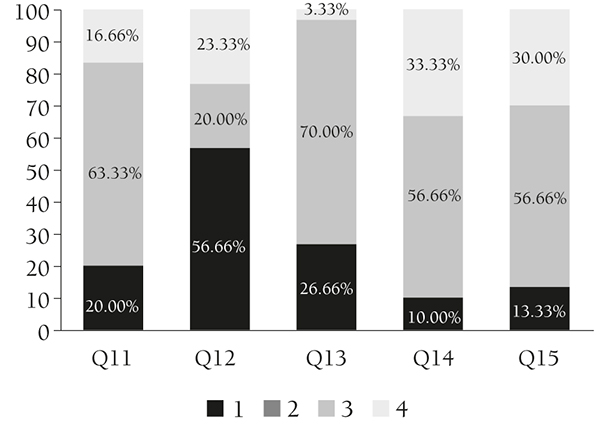
|
The answers about the EdPuzzle perceptions Q16, Q17, Q18, Q19 and Q20 can be seen in Figure 10, where it is observed that almost all the students would like the tool to be used in other topics. It can be also concluded that watching the videos several times helps them with their doubts and that is a good tool for the learning of Mathematics, while a significant majority find it a good complement to face-to-face classes as well as the totality highlights that it is a good tool for working on Mathematics in general.
|
Figure 10. Answers about the EdPuzzle perceptions (Q16, Q17, Q18, Q19 & Q20) 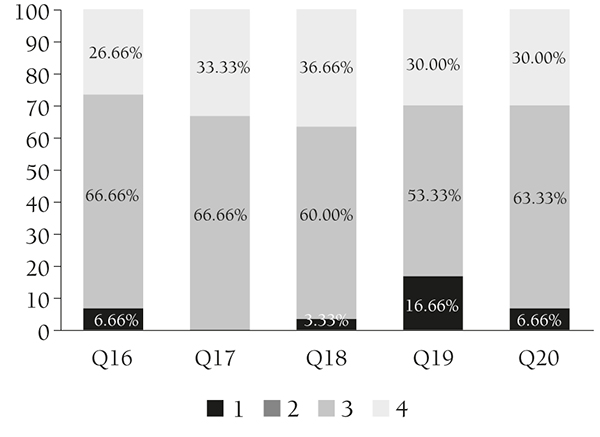
|
Regarding the question about the score to the tool in Mathematics, the mean value is identical to the mean in general with 7.23 points, so that the students value the experience in a remarkable way, highlighting again the “8” as the most repeated answer.
Finally, the following comments made by students about the tool can be highlighted:
These aspects lead to conclude that the tool has helped students in their learning process as they said they would like to use it more.
When a student listens to the explanation of a concept from a teacher, is a passive subject, and it is very probable that he or she is not understanding the explanation, but when he or she will truly realize his or her knowledge or the need the help of the teacher who guide him or her in learning process is during the application of those mathematical concepts. For this reason, this pedagogical model is very useful in Mathematics, since it allows the students to dedicate the entire class session in the classroom to solving problems and exercises in which they apply the concepts that they have previously visualized at home. In this way, teachers achieve that the student is an active subject throughout the Mathematics class while he or she can solve the learning difficulties and obstacles that the students may have in this resolution process (Plaza et al., 2020Plaza, L., González, J. & Vasyunkina, O. (2020). Obstáculos en la enseñanza-aprendizaje de la matemática. Revisión sistemática. En P. Balda, M. M. Parra & H. Sostenes (eds.), Acta latinoamericana de matemática educativa (pp. 295-304). Comité Latinoamericano de Matemática Educativa.; Tettay-Mejía et al., 2019Tettay-Mejía, S. I., Pulgar-García, M. & Rojas-Sandoval, Y. (2019). Errores en la resolución de problemas con ecuaciones de primer grado en estudiantes de secundaria. Praxis, 15(2), 193-205. https://doi.org/10.21676/23897856.3249) The results using Flipped Classroom confirm the ones shown in (Jordán et al., 2019Jordán, C., Magreñán, Á. A. & Orcos, L. (2019). Considerations about flip education in the teaching of advanced mathematics. Education Sciences, 9(3), 227.).
It is very important for this model to work, that the students watch the video at home. This is usually the biggest drawback to find, since most adolescents are used to consuming audio visual material immediately but that does not require reflection or understanding, which is why it is often difficult for them to work on these mathematical videos, and it is the greatest reluctance that teachers find in order to apply this pedagogical model in classrooms. The results obtained in this study agree with the results obtained about the uses of video in Rodríguez et al. (2017Rodríguez, R. A., López, B. S. & Mortera, F. J. (2017). El video como recurso educativo abierto y la enseñanza de matemáticas. Revista Electrónica de Investigación Educativa, 19(3), 92-100. http://doi.org/10.24320/redie.2017.19.3.936).
The effectiveness of the use of EdPuzzle, in the sample considered, has been studied and it has been concluded that the qualifications in the group which used EdPuzzle are higher according to the results obtained in Salazar-Hernández et al. (2019Salazar-Hernández, R., Pérez-Jasso, C., Lerma, A. M. & González, F. A. (2019). TICs y lúdicas como estrategias didácticas para mejorar los aprendizajes de matemáticas en educación básica. Informática y Sistemas: Revista de Tecnologías de la Informática y las Comunicaciones, 3(2), 39-50. ), where they show that the use of ICT in secondary Maths in a correct way can increase of the academic performance in Mathematics.
What it has been observed throughout this course is that the students have begun to give importance to this previous work at home and many of the students were able to start the classroom activities without requiring explanation of the teacher, which has allowed them to work with a higher level and more quickly in class.
Another advantage that EdPuzzle offers us is to record the student’s grade after having seen the video, according to the number of questions that they have answered correctly. This feedback allows the analysis of the difficulties that the understanding of this video has, and the attention that students have put in its visualization. It saves teachers time when grading, and allows to optimize even more, if possible, the time in the classroom for carrying out exercises and solving doubts.
Error is fundamental in the construction of learning (Cortina et al. 2013Cortina, J. L., Zúñiga, C. & Visnovska, J. (2013). La equipartición como obstáculo didáctico en la enseñanza de las fracciones. Educación Matemática, 25(2), 7-29. ), it allows to discover the concepts that the student has incorrect or incomplete, so errors have to be taken into account to develop learning activities that help them in the learning process, since if the error is underestimated in Mathematics, our students can be guided towards failure in this matter. This tool allows to detect the type of error that our students make, in an individualized way, whether it is an error in knowledge, know-how, the inappropriate use of a technique, or logical reasoning, being able to take the appropriate measures in each case.
In short, the fact of using this tool, in addition to substantially improving our experience with the Flip classroom, enables to have more time in the class sessions to help those students who need it most and to detect obstacles and learning difficulties.
The research of the third author was partially supported by the project Curso de Matemáticas Elementales para Maestros: Matebásicas of the Proyectos de Innovación Docente de la Universidad de La Rioja.
| ○ | Armsby, P. (2013). Developing professional learning and identity through the recognition of experiential learning at doctoral level. International Journal of Lifelong Education, 32(4), 412-429. https://doi.org/10.1080/02601370.2013.778070 |
| ○ | Casillas, S., Cabezas, M., Ibarra, M. & Rodríguez, G. (2020). El profesorado universitario en la sociedad del conocimiento: manejo y actitud hacia las TIC. Bordón. Revista de Pedagogía, 72(3), 45-63. https://doi.org/10.13042/Bordon.2020.76746 |
| ○ | Coa, R. E. (2018). Aprendizaje experiencial y el EdPuzzle en la solución de problemas contextualizados de sistemas de ecuaciones de matemática básica en estudiantes de una universidad privada 2018-I [Master´s Theses], Technological University of Perú. Lima. http://repositorio.utp.edu.pe/handle/UTP/1554 |
| ○ | Cornell, R., Johnson, C. & Schwartz, J. W. (2013). Enhancing student experiential learning with structured interviews. Journal of Education for Business, 88(3), 136-146. http://dx.doi.org/10.1080/08832323.2012.659296 |
| ○ | Cortina, J. L., Zúñiga, C. & Visnovska, J. (2013). La equipartición como obstáculo didáctico en la enseñanza de las fracciones. Educación Matemática, 25(2), 7-29. |
| ○ | Cronhjort, M., Filipsson, L. & Weurlander, M. (2017). Improved engagement and learning in flipped-classroom calculus. Teaching Mathematics and Its Applications, 37(3), 113-121. https://doi.org/10.1093/teamat/hrx007 |
| ○ | Crouch, C. H. & Mazur, E. (2001). Peer instruction: ten years of experience and results. American Journal of Physics, 69(9), 970-977. https://doi.org/10.1119/1.1374249 |
| ○ | Curto, M., Orcos, L., Blázquez, P. J. & León, F. J. M. (2019). Student assessment of the use of Kahoot in the learning process of science and mathematics. Education Sciences, 9(1), 55. |
| ○ | Douady, R. (1986). Jeux de cadres et dialectique outil-objet. Recherches en Didactique des Mathématiques, 7(2), 5-31. https://revue-rdm.com/1986/jeux-de-cadres-et-dialectique/ |
| ○ | Garzón, J. & Bautista, J. (2018). Virtual Algebra Tiles: a pedagogical tool to teach and learn algebra through geometry. Journal of Computer Assisted Learning, 34(6), 876-883. |
| ○ | Hamdan, N., McKnight, P., McKnight, K. & Arfstrom, K. M. (2013). The Flip Learning Model: a white paper based on the literature review of Flipped Learning. http://flippedlearning.org/wp-content/uploads/2016/07/WhitePaper_FlippedLearning.pdf |
| ○ | Hulse, T. (2019). Graspable Math K-12: perspectives and design for formative assessment of mathematical proficiency with learning technologies [Phd Thesis]. https://digital.wpi.edu/concern/etds/6q182n667 |
| ○ | Jordán, C., Magreñán, Á. A. & Orcos, L. (2019). Considerations about flip education in the teaching of advanced mathematics. Education Sciences, 9(3), 227. |
| ○ | Kolb, A. Y. & Kolb, D. A. (2009). Experiential learning theory: a dynamic, holistic approach to management learning, education and development. In S. J. Armstrong & C. V. Fukami (eds.), The SAGE handbook of management learning, education and development, 42, 68. http://dx.doi.org/10.4135/9780857021038.n3 |
| ○ | Margosian, K. (2018). Examining the effect of Flipped Learning on English language learner mathematics achievement. [Master´s Thesis]. California State University. https://digitalcommons.csumb.edu/caps_thes_all/295 |
| ○ | Marín, D., Vidal, M. I., Peirats, J. & López, M. (2018). Gamificación en la evaluación del aprendizaje: valoración del uso de Kahoot! In REDINE (ed.), Innovate strategies for Higher Education in Spain (pp. 8-17). Adaya Press. |
| ○ | Mazcuñán, E. M. (2015). Creación de lecciones a partir de vídeos con EdPuzzle. In Tele (in) 2 series: nuevos enfoques en la aplicación práctica de la innovación docente (pp. 47-52). |
| ○ | McLeod, S. (2019). What does effect size tell you? Simply Psychology. https://www.simplypsychology.org/effect-size.html |
| ○ | Mejía, M. F. (2012). ¿Cómo se podría enseñar la factorización de polinomios integrando calculadoras simbólicas y lápiz y papel? In O. Gilberto (ed.), Memorias del 13.er Encuentro Colombiano de Matemática Educativa (pp. 1171-1177). Sello Editorial Universidad de Medellín. |
| ○ | Méndez, T. (2012). Marco figural como medio para factorizar polinomios cuadráticos. Bolema: Boletim de Educação Matemática, 26(44), 1395-1416. |
| ○ | Novak, G. M., Gavrin, A., Wolfgang, C. & y Patterson, E. (1999). Just-in-time teaching: blending active learning with web technology. Prentice Hall PTR. |
| ○ | Orcos, L., Blázquez, P., Curto, M., Molina, F. J. & Magreñán, Á. A. (2018). Use of Kahoot and EdPuzzle by smartphone in the classroom: the design of a methodological proposal. In L. Uden, D. Liberona & J. Ristvej (eds.), Learning technologies for educational challenges (pp. 37-47). 10.1007/978-3-319-95522-3_4 |
| ○ | Ottmar, E., Landy, D., Weitnauer, E. & Goldstone, R. (2015). Graspable Mathematics: using perceptual learning technology to discover algebraic notation. In Integrating touch-enabled and mobile devices into contemporary Mathematics education (pp. 24-48). IGI Global. |
| ○ | Pincheira, N. & Vásquez, C. (2021). Recursos virtuales para la enseñanza del álgebra: un aporte para la priorización curricular chilena frente a la pandemia de la COVID-19. Unión-Revista Iberoamericana de Educación Matemática, 17(61), e009-e009. |
| ○ | Pintor, E., Gargantilla, P., Herreros, B. & López, M. (2014). Kahoot en docencia: una alternativa practica a los clickers. In XI Jornadas Internacionales de Innovación Universitaria. Universidad Europea de Madrid. http://abacus.universidadeuropea.es/bitstream/handle/11268/3603/x_jiiu_2014_322.pdf?sequence=2&isAllowed=y |
| ○ | Plaza, L., González, J. & Vasyunkina, O. (2020). Obstáculos en la enseñanza-aprendizaje de la matemática. Revisión sistemática. En P. Balda, M. M. Parra & H. Sostenes (eds.), Acta latinoamericana de matemática educativa (pp. 295-304). Comité Latinoamericano de Matemática Educativa. |
| ○ | Pueo, B., Jiménez-Olmedo, J., Carbonell-Martínez, J. & Penichet-Tomas, A. (2017). Aplicación de la herramienta EdPuzzle como experiencia transversal de clases invertida en distintas etapas educativas. XARXES-INNOVAESTIC 2017 (pp. 208-209). Universidad de Alicante. |
| ○ | Real Decreto de 1105/2014, de 26 de diciembre, por el que se establece el currículo básico de la Educación Secundaria Obligatoria y del Bachillerato (2014), Boletín Oficial del Estado, 3, sec. I, de 3 de enero de 2015, 169 a 546. https://www.boe.es/eli/es/rd/2014/12/26/1105 |
| ○ | Rodríguez, R. A., López, B. S. & Mortera, F. J. (2017). El video como recurso educativo abierto y la enseñanza de matemáticas. Revista Electrónica de Investigación Educativa, 19(3), 92-100. http://doi.org/10.24320/redie.2017.19.3.936 |
| ○ | Romero-Martín, R., Castejón-Oliva, F. J. & López-Pastor, V. (2015). Divergencias del alumnado y del profesorado universitario sobre las dificultades para aplicar la evaluación formativa. RELIEVE-Revista Electrónica de Investigación y Evaluación Educativa, 21(1). https://doi.org/10.7203/relieve.21.1.5169 |
| ○ | Salazar-Hernández, R., Pérez-Jasso, C., Lerma, A. M. & González, F. A. (2019). TICs y lúdicas como estrategias didácticas para mejorar los aprendizajes de matemáticas en educación básica. Informática y Sistemas: Revista de Tecnologías de la Informática y las Comunicaciones, 3(2), 39-50. |
| ○ | Sein-Echaluce, M. L., Fidalgo- Blanco, Á. & García Peñalvo, F. J. (2017). Trabajo en equipo y Flip Teaching para mejorar el aprendizaje activo del alumnado. Proceedings of IV Congreso Internacional sobre Aprendizaje, Innovación y Competitividad, 610-615. https://doi.org/10.26754/CINAIC.2017.000001_129 |
| ○ | Sosa, M. & Valverde, J. (2020). Perfiles docentes en el contexto de la transformación digital de la escuela. Bordón. Revista de Pedagogía, 72(1), 151-173. https://doi.org/10.13042/Bordon.2020.72965 |
| ○ | Tettay-Mejía, S. I., Pulgar-García, M. & Rojas-Sandoval, Y. (2019). Errores en la resolución de problemas con ecuaciones de primer grado en estudiantes de secundaria. Praxis, 15(2), 193-205. https://doi.org/10.21676/23897856.3249 |
| ○ | Webel, C. Sheffel, C. & Conner K. A. (2018). Flipping instruction in a fifth-grade class: a case of an elementary Mathematics specialist. Teaching and Teacher Education, 71, 271-282. https://doi.org/10.1016/j.tate.2018.01.007 |
| ○ | Weitnauer, E., Landy, D. & Ottmar, E. (2016, December). Graspable math: towards dynamic algebra notations that support learners better than paper. In 2016 Future Technologies Conference (FTC) (pp. 406-414). IEEE. |
| ○ | Wilson, A. (2016). The Flipped Approach: the use of embedded questions in Math videos. [Master thesis]. University of Texas. https://scholarworks.utep.edu/open_etd/983/ |
El uso de EdPuzzle para el aprendizaje de factorización polinómica en educación secundaria
INTRODUCCIÓN. Uno de los principales objetivos de la educación matemática es motivar al estudiantado ya que su interés por las matemáticas es muy bajo en muchos casos y, en otros, incluso nulo. El uso de diferentes tecnologías ha crecido bastante en las últimas décadas y varios autores en el área han demostrado su eficacia en el aula. Además, el uso de diferentes tecnologías de la información y la comunicación, que los estudiantes pueden utilizar en sus propias casas, también está creciendo. MÉTODO. En este estudio se presenta el uso de la aplicación EdPuzzle, bajo el paradigma de la metodología Flip Learning en el tercer curso de educación secundaria para el aprendizaje de la factorización polinomial en una escuela de España en dos cursos diferentes, impartidos por la misma profesora. Para llevar a cabo la experiencia, se han tomado las calificaciones promedio de dos exámenes, el primero de polinomios y sus propiedades, utilizado como pretest, ya que tiene los principales conceptos básicos que el alumnado debe conocer antes de continuar, y otro relacionado con la factorización polinómica, utilizado como postest, y se han comparado las calificaciones obtenidas por el grupo que utilizó EdPuzzle con las que no lo utilizó. RESULTADOS. La comparación de ambos grupos muestra que las calificaciones en el postest son significativamente mayores en el grupo que utilizó EdPuzzle. DISCUSIÓN. El tamaño del efecto de Cohen obtenido fue muy cercano a medio y los resultados de la encuesta de satisfacción fueron positivos, aspectos que hacen de EdPuzzle una herramienta que considerar para el proceso de enseñanza-aprendizaje en matemáticas.
Palabras clave: Flipped Classroom, Álgebra, Tecnología educativa, Educación matemática, Tecnología de vídeo.
L’utilisation d’EdPuzzle pour l’apprentissage de la factorisation polynomiale dans l’enseignement secondaire
INTRODUCTION. L’un des principaux objectifs de l’enseignement des mathématiques est de motiver les élèves puisque leur intérêt pour les mathématiques est très faible dans de nombreux cas et, dans d’autres, même nul. L’utilisation de différentes technologies s’est beaucoup développée au cours des dernières décennies et plusieurs auteurs du domaine ont démontré leur efficacité en classe. En outre, l’utilisation des différentes technologies de l’information et de la communication, que les élèves peuvent utiliser chez eux, est également en augmentation. MÉTHODE. Dans cette étude, l’utilisation de l’application EdPuzzle est présentée, sous le paradigme de la méthodologie de classe inversée (Flip Learning) en troisième année de l’enseignement secondaire pour l’apprentissage de la factorisation polynomiale dans un établissement en Espagne dans deux groupes différents où intervient la même professeure. Pour mener à bien l’expérience, les notes moyennes de deux examens ont été considérées, le premier des polynômes et leurs propriétés, utilisé comme pré-test car il contient les principaux concepts de base que les étudiants doivent connaître avant de continuer, et un autre lié à la factorisation du polynôme, utilisé en post-test. Finalement, les scores obtenus par le groupe qui a utilisé EdPuzzle ont été comparés à ceux qui ne l’ont pas utilisé. RÉSULTATS. La comparaison des deux groupes montre que les scores post-test sont significativement plus élevés dans le groupe qui a utilisé EdPuzzle. DISCUSSION. La taille de l’effet Cohen obtenue est très proche de la moyenne et les résultats de l’enquête de satisfaction sont positifs, des aspects qui font d’EdPuzzle un outil à considérer dans le processus d’enseignement-apprentissage des mathématiques.
Mots-clés: Classe inversée, Algèbre, Technologie éducative, Enseignement des mathématiques, Technologie vidéo.
Cristina Jiménez
PhD student at Universitat Politécnica de Valencia. Cristina is working as lecturer in Universidad Internacional de La Rioja and opting for the title of PhD at Universitat Politècnica de València.
Código ORCID: https://orcid.org/0000-0002-0189-4910
E-mail: cjimher@doctor.upv.es
María Arantzazu Jadraque
She is working as lecturer in Universidad Internacional de La Rioja.
Código ORCID: https://orcid.org/0000-0002-5137-7786
E-mail: aranchajadraque@concepcionistas.es
Ángel Alberto Magreñán (corresponding author)
He is currently in “contract” status at Universidad de La Rioja. He has been working in the last three years at Universidad de La Rioja and before that he was professor at Universidad Internacional de La Rioja. He has a PhD in Mathematics obtained in 2013 and has published more than 90 papers.
Código ORCID: https://orcid.org/0000-0002-6991-5706
E-mail: angel-alberto.magrenan@unirioja.es
Correspondence address: C/ Madre de Dios 53, 26006 Logroño (La Rioja).
Lara Orcos
She is an Associate Professor at Universidad Internacional de La Rioja (UNIR).
Lara has been working in the five three years at Universidad Internacional de La Rioja and before that she was teacher at a School in Logroño. She has a PhD in Mathematics Education obtained in 2019 and has published several papers.
Código ORCID: https://orcid.org/0000-0001-8138-551X
E-mail: lara.orcos@unir.net